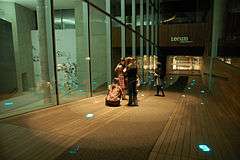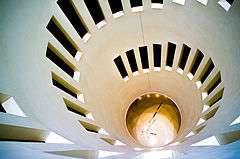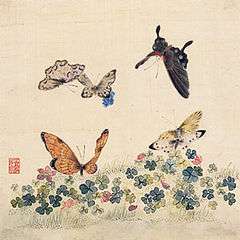Leeum, Samsung Museum of Art
The Leeum, Samsung Museum of Art is a museum in Hannam-dong, Yongsan-gu, Seoul, South Korea, run by the Samsung Foundation of Culture.[1] It comprises two parts that house traditional Korean art and contemporary art. Museum 1 is designed by Swiss architect Mario Botta and Museum 2 is by French architect Jean Nouvel and Dutch architect Rem Koolhaas designed the Samsung Child Education & Culture Center.[2]
| Leeum, Samsung Museum of Art | |
|---|---|
삼성미술관 리움 | |
 | |
| General information | |
| Type | Art Museum |
| Address | 747-18 Hannam 2-dong, Yongsan-gu, Seoul, South Korea 140-890 |
| Town or city | Seoul |
| Country | South Korea |
| Completed | 2004 |
| Client | Samsung Cultural Foundation |
| Design and construction | |
| Architect | Mario Botta, Jean Nouvel, Rem Koolhaas |
| Architecture firm | Mario Botta Architetto, Ateliers Jean Nouvel, Office for Metropolitan Architecture, Samoo Architects & Engineers |
| Structural engineer | Chunglym Engineers |
| Other designers | Landscape: Petra Blaisse |
| Awards and prizes | 2005 Excellence in Design for Civic Architecture Seoul Metropolitan Government |
| Website | |
| Official Website | |
| References | |
| http://oma.eu/projects/2004/leeum-museum | |


Collection
Museum 1, designed by Mario Botta, houses a collection of traditional Korean art, of which 36 pieces are designated national treasures. Included in the collection are landscapes and folk paintings, traditional ceramics and porcelain, such as Celadon and Buncheong, a bluish-green traditional Korean stoneware. As well as 14th century daggers, crowns, earrings and ornaments; and Buddhist art, sculptures, paintings and manuscripts.[3]
Two large volumes, a reverse cone and a simple hexahedral shape, form Museum 1. Mario Botta utilized terra cotta bricks on the building’s façade which creates not only a strong presence on the grounds but also creates a chameleon like façade which changes colors, and plays with shadows, with the changing intensity and angle of sunlight. The shapes and materials create a modern interpretation of Seoul’s history as a walled city and reference the traditional ceramic art inside.[4]
The interior of Museum 1 includes a lobby, rotunda, and exhibition spaces. The core of the Leeum Museum is this basement lobby created by the reverse cone penetrating the ground. Museum 2 and the Samsung Child Education & Culture Center are all connected here. Museum goers begin and end their tours in this area. Above the lobby is the white walled rotunda. Spiraling down like a helix, the rotunda delivers natural light into the basement lobby and exhibition spaces. The exhibition spaces in Museum 1 are hexahedral. Visitors begin at the top and walk down visiting each of the four floors which house ceramics, swords, jewelry and other traditional Korean artifacts.[4]
Museum 2, designed by Jean Nouvel, features modern and contemporary art from both Korean and foreign artists.[5] Many famous artists such as Damien Hirst, Warhol, Rothko, Yves Klein and Donald Judd have permanent exhibition spaces.[6] The basement levels of the museum face the sunken garden and gabion walls. The gabion cages are composed of iron and filled with rocks unearthed during the construction process. The sunken garden includes birch trees and ferns.[7][8][9]
Seemingly floating in place, Nouvel’s creation personifies modern art’s constant growth, evolution, and challenge/inquisition of society. Nouvel used extra white glass and rusted stainless-steel, the first to do so, to create the exhibition boxes. Many tests were performed before the current black-filmed stainless-steel could be created. The freely arranged exhibition boxes penetrate the glass skin and allow for a more controlled exhibition space. Light and other factors can be readily controlled for each box. The main exhibition hall in Museum 2 is a completely open space without any supporting posts thanks to post-tension building techniques.[7]
Rem Koolhaas was charged with designing the Samsung Child Education & Culture Center as well as the museum’s master plan. The main entrance into the lobby of Museum 1 is through Koolhaas’s glass structure. As they enter the museum, visitors follow along on a wooden ramp and pass under a pavilion, demarcating the threshold. He used pilotis which not only lighten the structure but also provide a view of the surrounding buildings and site. The skin of the three story outer building is composed of steel and glass. Inside, a mixing chamber was created between the glass wall and Black box and the placement of lighting, piloti and ramps.[10] The Black concrete box holds different exhibits.[11]
Located over the parking garage, the Sculpture Garden showcases sculptural exhibits. The garden consists of a long rectangular strip of gravel and vegetation and the wood deck which frames it. Recently two of Louise Bourgeois’s Maman sculptures were featured in the Sculpture Garden.[12][13]
Publications
- Korea Herald, 9 December 2010
A+U #422, 11/05 Archiworld, Culture, Project Type 9, Seoul, 2005 Arcspace
- Dolcevita*, 06
Interni #552, 06/05 Sixty Six World New Architecture 2, 2006
See also
References
- "Leeum, Samsung Museum of Art Travel Guide - Seoul City, South Korea". Lifeinkorea.com. Retrieved 2014-03-28.
- CNN Go Seoul's best museums Archived 2012-09-28 at the Wayback Machine 27 October 2011. Retrieved 2011-11-04
- "Architecture | Leeum, Samsung Museum of Art". Leeum.samsungfoundation.org. Retrieved 2014-03-28.
- "MUSEUM 1 | Leeum, Samsung Museum of Art". Leeum.samsungfoundation.org. Retrieved 2014-03-28.
- "Blog Archive » Leeum Museum by Mario Botta, Jaen Nouvel, Rem Koolhaas". e-seoul.org. 2010-03-10. Retrieved 2014-03-28.
- "ArtPremium – The Leeum Museum: "Korean Rhapsody"". ArtPremium. 2018-04-13. Retrieved 2018-05-03.
- "MUSEUM 2 | Leeum, Samsung Museum of Art". Leeum.samsungfoundation.org. Retrieved 2014-03-28.
- "Leeum Samsung Museum introduction" (in Korean). Akive. Retrieved 2014-03-28.
- "dcdomain - r9: Dae Han Min Guk Day 3". Blog.dcdomain.org. Retrieved 2014-03-28.
- "Oma- Leeum-Museum". Oma.eu. 2011-06-29. Retrieved 2014-03-28.
- "Samsung Child Education & Culture Center | Leeum, Samsung Museum of Art". Leeum.samsungfoundation.org. Retrieved 2014-03-28.
- http://blog.dcdomain.org/2008/04/dae-han-min-guk-day-3.html%5B%5D
- http://leeum.samsungfoundation.org/html_eng/introduction/structure03.asp%5B%5D
External links
| Wikimedia Commons has media related to Leeum, Samsung Museum of Art. |